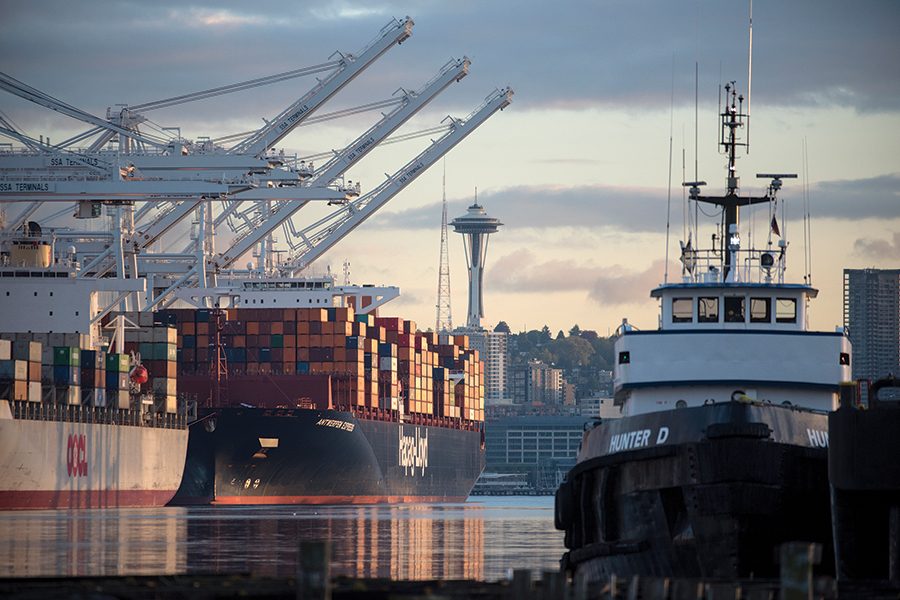
Home » Value of ag exports is up, but there’s a hitch
Value of ag exports is up, but there’s a hitch

June 13, 2022
Washington state saw the value of agriculture exports increase by more than $1 billion in 2021.
There’s a big asterisk tied to the impressive $7.7 billion figure for agricultural products originating in Washington.
“Be clear that while values are up, volumes are predominantly down,” said Rianne Perry, manager for international marketing at the Washington State Department of Agriculture, which tracks export statistics.
Inflation and supply-chain related bumps drove up prices and, by extension, shipping values.
Washington exported
$21.7 billion of ag products, a figure that reflects wheat, soybeans and other products that passed through the state en route to foreign markets.
The decline in volume doesn’t apply to all the Washington-grown products shipped overseas. But it was true for most, Perry said.
Empty containers
The problem in 2021 was the same as the year prior: Oceangoing vessels unload at the Ports of Seattle and Tacoma – collectively the Northwest Seaport Alliance – and leave with more empty containers than full ones.
“They can make more money going back to Asia with empty shipping containers,” she said.
Perry said it isn’t a question of demand. Washington-grown products have buyers ready.
“There are a lot of lost sales. These are products that have buyers – they just can’t get product to them,” she said.
The number of empty containers leaving the port is growing. According to the alliance, it grew to 836,000 in 2021, up 41% over the year prior.
Collectively, the two ports handled 3.7 million containers in 2021. Of those, 1.46 million arrived full and 692,000 left full.
In May 2021, for the first time, more containers departed empty than full.
Not coincidentally, The Northwest Seaport Alliance noted a 30% drop in agricultural commodities shipped in the last half of 2021.
That was a difficult shift, said Melanie Stambaugh, communications director for the Northwest Seaport Alliance.
The alliance ports were balanced prior to the pandemic – receiving as many loaded containers as they sent out.
“We really prided ourselves on that,” she said.
In a bid to reverse the trend, the alliance is collaborating with the U.S. Department of Agriculture on near-dock facilities where shippers can send containers ready to load.
A 49-acre “pop up” yard at Seattle’s Terminal 46 began operating this spring. Another is being prepared at a near-dock facility at the Port of Tacoma. The facilities can handle refrigerated cargo as well as Washington’s top ag exports – hay and forage materials.
For shippers, the extra step of leaving a container near the dock would normally add the extra expense associated with dropping off and picking up a container. The federal agency is covering the cost – $400 for refrigerated containers and $200 for nonrefrigerated ones.
The USDA is partnering with the Port of Oakland, California, on a similar project while the U.S. Department of Transportation is working with the Port of Savannah, Georgia, to ease shipping congestion.
Trends to celebrate
While shipping is a struggle, there are trends to celebrate in ag exports.
In 2021, Canada remained the top buyer of Washington-grown food and agriculture, followed by Japan, China, South Korea and Mexico. Our neighbors to the north purchased $1.36 billion worth of fish and seafood, fresh apples, sweet cherries, onions and fresh berries.
Japan, No. 2, purchased $1.2 billion of hay, frozen french fries, fish and seafood, wheat and beef.
China moved up to No. 3 as it bought U.S. commodities to comply with the United States-China Phase One Trade economic and trade agreement, approved in 2020 during the Trump administration.
Under the agreement, China agreed to purchase wheat and other Washington-grown products. The numbers ticked up in 2021, with China purchasing nearly $1 billion worth of wheat, hay, beef, fish and seafood and dairy. Perry doesn’t believe that level of spending is sustainable.
“My crystal ball would be that this won’t continue. I think some of this is the obligation of the Phase One agreement. I would expect for things to settle back in the $400 million-$500 million range, which is where our exports to China have been,” she said.
South Korea, No. 4, purchased $541 million worth of wheat, hay, french fries, frozen, sweet cherries and dairy.
Mexico moved up a spot to No. 5 on the strength of its apple purchases.
“We were really happy to see Mexico bounce back to No. 5,” Perry said.
Mexico purchased $457 million worth of apples, frozen french fries, dairy, pears, hop cones and extracts. Fresh potatoes were notably missing from its shopping list.
U.S. potato growers have long coveted the market but were barred from shipping beyond a narrow zone along the U.S.-Mexico border. Mexico’s Supreme Court voted 5-0 in April 2021 to end the embargo.
Mexico accepted its first shipments of U.S. fresh potatoes on May 11, 2022.
“The Washington potato industry is excited about it,” she said.
Who’s buying?
Frozen french fries, widely produced in the Mid-Columbia, rose to $847 million, an inflation-matching 8%. Top buyers include Japan, South Korea and the Philippines.
Sweet cherries, also widely grown in the Mid-Columbia, declined sharply, falling to $267 million, a 22% decline. The infamous late June heat dome that settled over the Pacific Northwest and sent temperatures unseasonably high affected cherries, berries and even some vegetables. Canada, South Korea and China are the biggest international markets for cherries.
Apples, Washington’s signature product, is the fourth most-exported product with a value of $643 million in 2021, up 1%. Buyers included Mexico, Canada and Taiwan.
The biggest gains in value were posted by wheat and beef, both driven by demand from China. Washington wheat growers exported $962 million worth of wheat in 2021, a 45% gain in value, and $317 million worth of beef, a 49% gain in value.
Washington’s top exports in 2021
Fish and seafood: $1.2 billion
Wheat: $962 million
Frozen french fries: $847 million
Fresh apples: $643 million
Dairy: $627 million
Hay: $623 million
Hop cones and extracts: $337 million
Beef: $317 million
Sweet cherries: $267 million
Pulses (dry peas, beans, chickpeas, lentils): $137 million
Total exports: $21.7 billion
Washington grown: $7.7 billion
Source: Washington State Department of Agriculture
Agriculture + Viticulture
KEYWORDS june 2022





